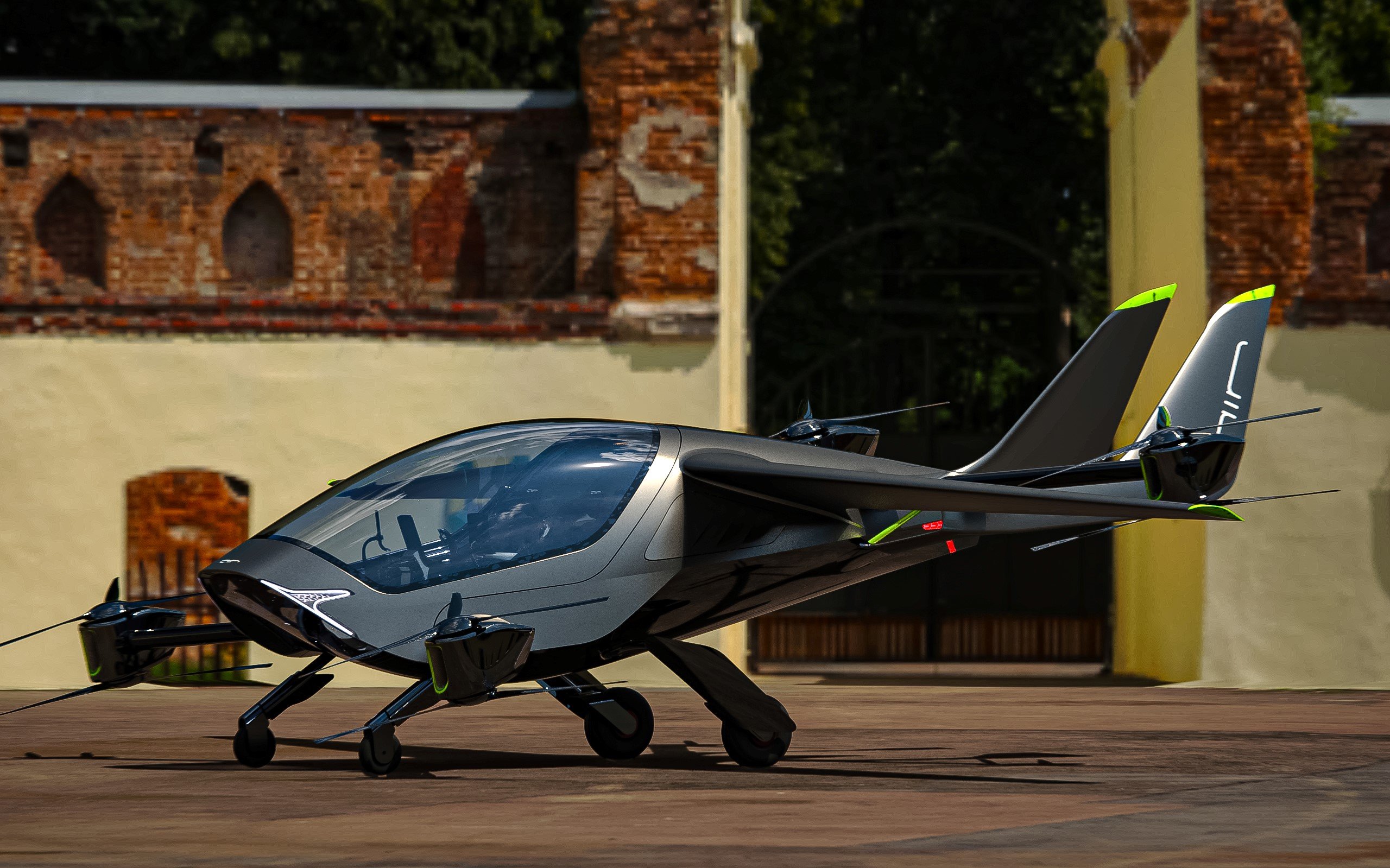Click Here to View This Page on Production Frontend
Click Here to Export Node Content
Click Here to View Printer-Friendly Version (Raw Backend)
Note: front-end display has links to styled print versions.
Content Node ID: 419259
Air this week unveiled the design for its two-seat eVTOL vehicle and announced that it is accepting preorders. The Israel-based start-up is positioning the Air One model for the consumer market, for owners who would fly the all-electric aircraft themselves. It anticipates making its first deliveries in 2024.
The design drawings released on October 19 show a fixed-wing aircraft with eight electric motors, each with a pair of three-bladed rotors, and a boom tail. The front pair of motor/rotor units are attached to the lower side of the fuselage, while the rear sets are mated to the fuselage at the same point as the tail section.
The Air One is expected to offer a range of up to 110 miles (or a flight duration of one hour) on a full electric charge, at speeds of 155 mph. Chief technology officer Chen Rosen told FutureFlight that the above-average range for an all-electric eVTOL is mainly possible because most of the weight has been transferred to the wing.
Some of the weight savings, as well as significantly reduced complexity, come from a decision to avoid tilting either the rotors or the wing to handle the transition from hover to cruise flight. Instead, the aircraft flies in a similar way to a helicopter, with the pilot raising the nose around 15 degrees for takeoff and then pitch down to transition to cruise flight.
Apart from the rotors, there are essentially no moving parts and Rosen said that the resulting weight savings have delivered more range even without making use of a dual-power system. Once the aircraft is on the ground, the wings will fold in to allow it to park in more confined spaces.
Air is now building the first of several full-scale prototypes and aims to start hover testing one of these without a pilot on board in early 2022. The first manned test flight is projected to happen in June next year, with the company already having flown several large-scale models.
According to CEO Rani Plaut, Air is strongly influenced by automotive manufacturing techniques and, as far as possible, has sourced off-the-shelf components and parts rather than developing these from scratch. Having finished design work for the prototype, the engineering team is now integrating the components for it and has set up a test bench for the electric motors.
Since 2019, the company has been in talks with the FAA to agree on the basis for type certification. It is engaged in the process of securing the G1 issue paper it requires to embark on the approval process. According to Plaut, Air is set to benefit from the earlier work done by other eVTOL developers to encourage FAA officials to define special conditions for certifying the new type of aircraft under existing Part 23 rules.
While Air is now taking preorders for its eVTOL, it will not publish the base purchase price until early 2022. “We consider this [the Air One] to be a vehicle rather than an aircraft," Plaut said. "It’s going to be like ordering a car with various options available. We think people will find the price very surprising because of the cost savings from the production techniques we are using by taking things that are old news in the automotive world.”
The company expects that existing private pilots will be part of the initial customer base for the Air One, but its aim is to make the eVTOL extremely simple to operate, requiring only the most basic sports flying license. Rosen said that Air’s “fly by intent” software can “reduce the hassle of flight” by handling tasks like navigation and providing built-in safety protection to ensure that the operator does not exceed the safe limits of the aircraft. “What we call the auto copilot is the envelope,” he explained. “It takes your intent, processes what you want the aircraft to do.”
Air is also using an artificial intelligence-based monitoring system that conducts frequent inspections of the vehicle and eliminates checklists for operators with minimal flight training. Plaut compared this approach to the monitoring systems in modern cars that assess the safe operation of all systems without drivers giving these a second thought.
For now, Air is not disclosing who its key partners and suppliers will be, and Plaut acknowledged that these could change as the program moves to high volumes of production. “We’re in discussions with all the obvious suspects,” he said.
“The future of mobility is in the sky, but to get there we need to build consumer confidence in eVTOLs as a legitimate mode of everyday transport and develop vehicles on a mass-scale to bring that vision to life,” Plaut said. “Air One is our hat in the ring, simultaneously showing consumers the first in a line of diversified, playful models for personal flight and demonstrating cutting-edge technology that will enable high-volume production and scalability.”
Meanwhile, the company—which has so far been backed by individual investors—is in the process of raising more funds. “Our first task is to build the company, and we don’t have a specific desire to go public,” Plaut commented.
